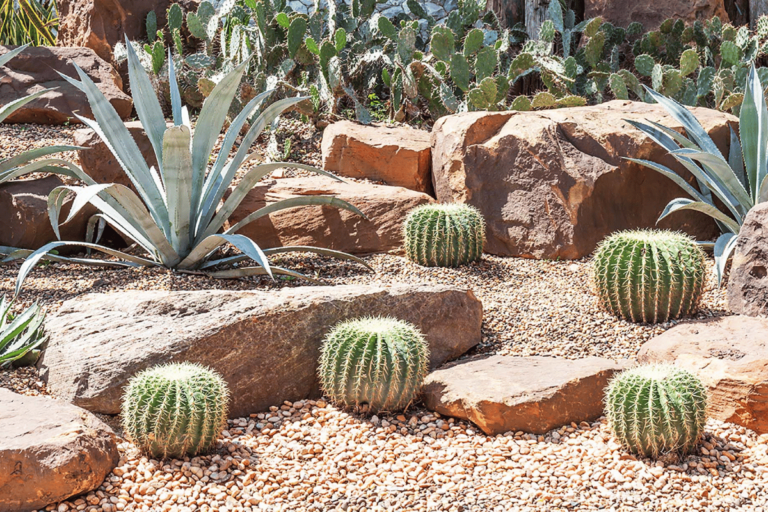Understanding the Basics of Xeriscaping
Xeriscaping is a method for gardening and landscaping that concentrates on
conserving water. Derived from the ancient Greek word for ‘dry,’ xeriscape
involves choosing plants that don’t need much water, using efficient irrigation
systems and creating landscapes that use little water. This approach is advantageous
in areas with low rainfall or frequent droughts.
Planning and Design
The principles behind xeriscaping include planning, soil improvement,
irrigation efficiency and plant selection. First, assess your landscape to
incorporate water-saving practices into your design. According to their
watering needs, group plants to minimize water usage while reducing evaporation
with hardscapes like rocks and gravel.
Example: Group plants according to hydrazones to avoid water wastage and
ensure they receive the right amount of moisture.
Soil Improvement
Good soil quality is imperative for successful xeriscaping. Add organic
matter such as compost to increase its ability to hold water and increase
nutrient content in the soil. Mulching helps maintain soil moisture, prevent
evaporation, and suppress weeds.
Example: Enhancing the soil’s structure by adding compost holds more
moisture in it, which helps maintain the excellent health status of plants.
Efficient Irrigation
Irrigation efficiency is vital in xeriscaping. For instance, you can apply
drip irrigation or use soaker hoses instead, which deliver water at roots only,
thus minimizing evaporation and runoff. Water should be applied in the early
morning or late evening hours when there is minimal chance of losing much
through evaporation. It is even worth installing a rainwater harvesting system to
collect runoff for later use.
Example: Drip irrigation systems are highly efficient because they deliver
the right amount of water directly into the root zone where it’s most needed.
Design Tips for a Water-Wise Landscape
Designing a xeriscape involves thoughtful planning and creative use of
plants and materials. Select drought-resistant plants that are suitable for the
climate and soil in your area. Native plants are excellent since they have
evolved to cope with weather conditions and require minimal water. Some common
xeriscape plants include lavender, yucca, agave, and ornamental grasses.
Plant selection
To create visual interest and variety, incorporate different types of plants,
including ground covers, shrubs, and trees. Use hardscapes like gravel paths,
stone patios or decorative rocks to add texture while reducing the water needed
for your landscape. These can also serve as focal points or demarcate separate
areas within the garden.
For example, Sagebrush, juniper, and cacti, among others, are considered
natural choices for xeriscaping because they have low water requirements and
are adapted to suit local regions.
Use of Hardscapes
Hardscape elements decrease the area requiring watering while adding
aesthetic value. Pathways made from materials such as gravel or stones form
patios that contribute to the beautification of your garden besides being water-saving.
Example: Additional benefits include reduced maintenance and provision of
durable outdoor surfaces through having a path made out of pebbles or a patio
constructed using rocks.
Raised Beds and Terracing
The aim is to improve drainage by raising beds or terracing, thus making the
landscape more dynamic. Raised beds could be filled with well-draining soil
mixtures favouring desert plant species. This method also slows down soil
erosion formation with distinct planting zones.
Example: Succulents do well in raised beds containing sand mixed with
compost or other soils that drain correctly.
Mulching:
Cover your soil with mulch to hold moisture. Wood chips or straws are
organic materials used as mulch, which decompose and nourish the soil for an
extended period. Inorganic types of mulch include pebbles or gravels that last
long and help reduce water loss.
Example: Putting mulch in thick layers around plants helps the soil stay
cool, conserves moisture, and suppresses weeds.
Conclusion
Following these design tips and incorporating xeriscaping principles into
your garden will give you a sustainable, cost-effective landscape for water use
while remaining attractive. Consequently, there will be no need to use so many
chemical fertilizers or insecticides since it facilitates water conservation
and does not promote environmental degradation but healthiness.
Efficiency in landscaping tactics combined with drought-resistant plant
selection renders your gardens evergreen even during the dry spells when little
watering would otherwise seem sufficient. Irrespective of whether you live in
an arid region or desire reduced water usage, xeriscaping provides a beautiful
yet practical solution for eco-friendly gardening.
Explore More Gardening Tips and Ideas
Source: The Benefits Of Xeriscapin


